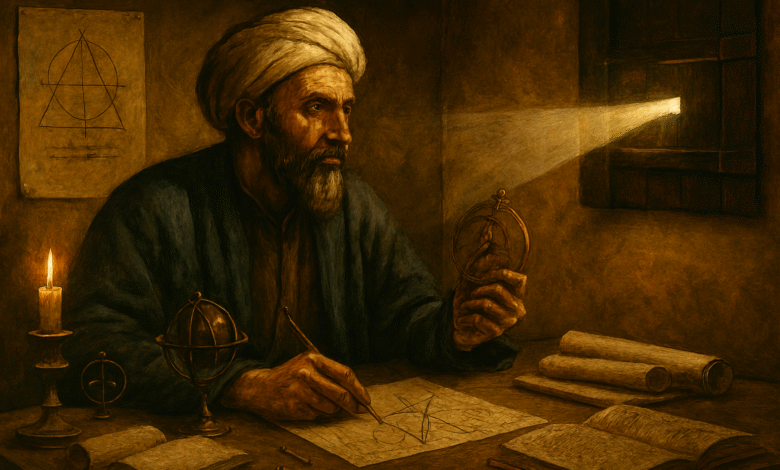Ibn al-Haytham (Alhazen): Vision, Evidence, and the Architecture of Light

▼ Summary
– Ibn al-Haytham pioneered the scientific method by emphasizing hypothesis, experimentation, and verification over inherited authority.
– His major work, “Kitab al-Manazir,” overturned the Greek emission theory of vision by proving light travels from objects to the eye.
– He conducted groundbreaking experiments with the camera obscura, demonstrating that light travels in straight lines and forms images.
– His studies on reflection, refraction, and lenses influenced later European scientists like Kepler and Newton.
– Beyond optics, he contributed to astronomy, mechanics, and psychology, consistently applying empirical testing to all fields.
In the early 11th century, a scholar from Basra began asking how we see, not metaphorically, but physically. How does light move? How do images form? What role does perception play? His name was Abu Ali al-Hasan ibn al-Haytham, known in the Latin West as Alhazen, and his inquiry into optics reshaped the study of physics, mathematics, and scientific reasoning.
Ibn al-Haytham didn’t inherit a tradition of experimentation. He built one. At a time when inherited authority often outweighed observation, he argued that knowledge must be tested, not accepted. His work introduced a method of inquiry grounded in hypothesis, experimentation, and verification, a structure that would later be recognized as the scientific method.
A New Way of Seeing
His most influential work, Kitab al-Manazir (The Book of Optics), written between 1011 and 1021 CE, challenged centuries of assumptions about vision. Greek thinkers like Ptolemy and Euclid had claimed that sight involved rays emitted from the eyes. Ibn al-Haytham reversed the model: light travels from external sources to the eye.
He didn’t stop at theory. He constructed dark chambers, used pinholes, and observed how light behaved under controlled conditions. His experiments with the camera obscura, a device that projects an inverted image through a small aperture, demonstrated how light travels in straight lines and how images form on surfaces.
He also studied reflection, refraction, and the behavior of light through transparent media. His mathematical treatment of optics blended geometry with physical observation. He described how the eye processes light, how lenses bend it, and how perception can be distorted. These insights later influenced European scholars including Roger Bacon, Kepler, and Newton.
Beyond Optics
Ibn al-Haytham’s intellectual reach extended far beyond light. He wrote on astronomy, geometry, mechanics, and psychology, always with the same insistence: ideas must be tested. In his treatise on celestial motion, he criticized Ptolemaic astronomy for its inconsistencies and proposed alternatives grounded in observation. In his studies of motion and force, he anticipated principles that would later appear in classical mechanics.
He also explored the nature of perception and cognition, arguing that the mind plays an active role in interpreting sensory data. This was centuries before psychology emerged as a formal discipline.
His writing style was methodical and transparent. He documented his procedures, acknowledged uncertainty, and invited scrutiny. He didn’t present conclusions as final. He treated them as provisional, open to revision through further evidence.
Timeline of Impact
- c. 965 CE: Born in Basra, Iraq
- c. 1011–1021 CE: Authors Kitab al-Manazir (The Book of Optics)
- Early 11th century: Conducts experiments on light, vision, and the camera obscura
- Mid-11th century: Writes on astronomy, mechanics, and psychology
- 12th–17th centuries: Latin translations influence European science
- Modern era: Recognized as a founder of empirical methodology and optical physics
Ibn al-Haytham’s legacy is not a list of discoveries. It’s a shift in how knowledge is built. He treated observation as the starting point, documented failure, revised his models, and separated what could be seen from what could be assumed. His work earned credibility through process, not prestige.
In an age where data is abundant but interpretation is contested, his insistence on evidence over authority remains essential. His contributions to optics laid the groundwork for modern imaging, photography, and visual computing. His approach to inquiry shaped the architecture of science itself.
Alhazen didn’t claim certainty. He built systems for testing it.